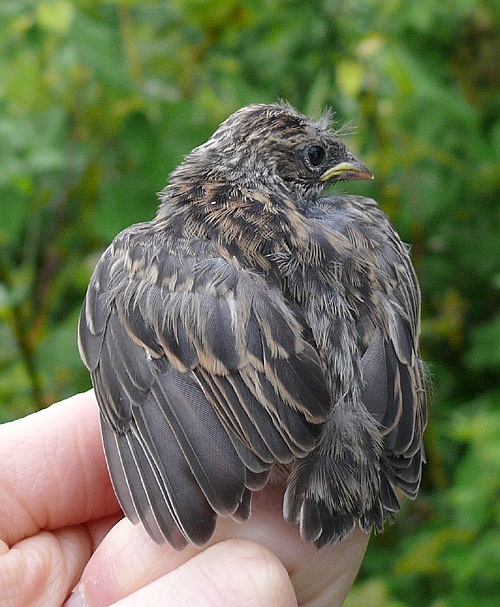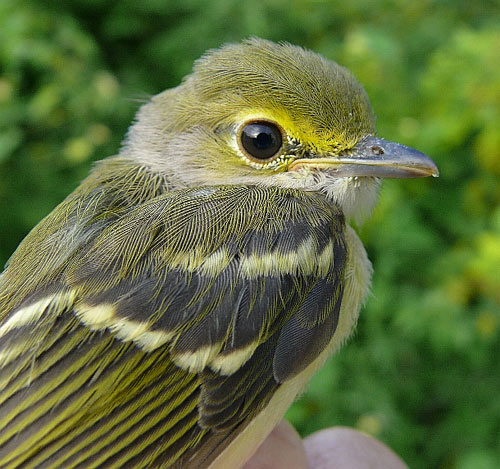June - July, 2008
A Panorama of Clouds at Powdermill, Summer 2008

The Powdermill banding station was operated on 41 days in June and July, with an average effort of 100 net-hours per day. Molly McDermott continued as our Bander-in-Charge through June, and Andrew Vitz assumed that position in July. In the photo to your left, one of Andrew's first official acts was to show bird-banding to a group of Powdermill's young summer nature day-campers.

We banded 834 birds (20 birds per 100 net-hours) of 60 species and processed 332 recaptures. Best single day was July 6, with 67 birds of 23 species banded (46 birds/100 net-hrs.), plus nine recaptures.
Top ten species during the summer banding season were American Redstart (109 banded), Gray Catbird (101), Cedar Waxwing (86), Louisiana Waterthrush (57; most of these were banded as part of focused long-term study at Powdermill), Song Sparrow (52), Eastern Phoebe (42), Wood Thrush (41), Red-eyed Vireo (33), Hooded Warbler (31), and Ruby-throated Hummingbird (30). One third of the 60 species banded this summer were represented by just a single bird.
Many thanks to volunteers Mary Shidel, Pam Ferkett, Bob Leberman, Jim Gruber, Matthew Shumar, Danilo Mejía, Marisabel Paulino, Gerardo Rodríguez Ramos, Jean Rothe-Deo, and Rob Slebodnik for their help with the banding this summer.
A total of 80 visitors signed our guest book this summer, including spring banding workshopper Jean Ploutz and her grandson Matthew (Pictured Left), students attending Dr. Anthony Bledsoe's Field Ornithology class at the University of Pittsburgh's Pymatuning Laboratory of Ecology, and Mary Shidel's family who came to see what this bird banding business that she volunteers for is all about!

A visiting Pymatuning Lab field ornithology student

Powdermill banding volunteer, Mary Shidel (banding data sheets in hand), and her family







As expected, many of the birds banded in the first half of the summer season were very recently fledged young (banding code "L" for Local vs. "HY" for Hatching Year).
As we have said on this website before, when we catch birds like these in our nets (i.e., very young birds incapable of sustained flight because their wings and tails are not fully grown in), we always give them first priority for rapid processing at the banding lab, and we take them back as soon as possible to a location near where they were captured.
In fact, we often facilitate a family reunion even before the parents have stopped fussing about their fledgling having been caught in the first place!
Pictured left (top to bottom): Chipping Sparrow, Common Yellowthroat, Eastern Phoebe, Wood Thrush, Gray Catbird, Yellow Warbler, and White-eyed Vireo.
Note the very soft, fleshy, yellowish gape on all these "baby" birds (makes them all look unhappy, doesn't it!) and the wispy traces of natal down still clinging to a few of them. Again, very young birds with this sort of appearance are still entirely dependent on parental care (for 2-3 weeks longer), and we make every effort to quickly reunite them with their parents and brood mates.


We didn't have to take these two fledgling Red-winged Blackbirds very far after banding them: for several days we had been watching them feeding themselves (but still begging from their mother whenever possible!), and holding their own against other birds and squirrels on the feeding platform right outside the banding lab window.


Birds caught in full juvenal plumage can often pose a significant identification challenge because the field marks that we know them by in adult plumages may not be present - for example, the mouse gray juvenal plumage of HY Yellow Warblers and the drab dirty yellow feathering of the young Common Yellowthroat pictured to the left top.
In addition, it is sometimes the case that two species can be much harder to tell apart in juvenal plumage than in their adult plumage. For example, the two juvenile sparrows below both have streaked breasts, but only one of them has prominent streaks as an adult. We have compared these two species side-by-side a few time before. Do you remember which is the Song and which is the Swamp (and why)?
The Swamp (on the left) has a thinner, proportionately longer bill.


The partial first prebasic molt that a juvenile bird undergoes within the first month or two after fledging ordinarily gives it a plumage that superficially resembles that of an adult, but it also creates the molt limits that banders can use to determine its age. And, this applies not only to HY birds, but also to SY birds (up until the time when they have undergone their second, complete or definitive prebasic molt).
On 28 June, we banded an adult Yellow-throated Vireo that we determined to be a second-year bird based on wing molt limits that were created upon completion of its partial first prebasic molt nine or ten months prior. Molt limits can be seen in both of the photos to your left. In the first photo, the smallest of the three alula feathers (just below the bend of the wing) molted last fall, while the contrastingly much browner middle and distal alula feathers are retained from the juvenal plumage.
In the spread wing photo, the molted proximal alula feather, or alula covert, again stands out plainly. Again, the two larger alula feathers are retained juvenal, as are all of the primary coverts and all of the long wing feathers except for the innermost three (i.e., the tertials).
The tertials, a few inner median coverts, and the scapulars (the line of feathers between the wing and the body) were included in a partial first prealternate molt (the are much fresher than the surrounding feathers replaced during the prebasic molt in the previous fall). The limit created by the molt of these feathers is not helpful for ageing, because both adult (i.e., ASY) and young (SY) YTVIs undergo a partial prealternate molt in late winter or early spring.





Assorted photo highlights from this summer included (top to bottom):
An ASY male American Redstart on 27 July (remember, an SY-M would be in a female-like plumage or just be starting to molt from the gray-and-yellow
into the definitive black-and-orange plumage of an adult male).
An SY male Magnolia Warbler on 28 June (just as showy and bright in its body plumage as any ASY male would be).
A phenotypically "pure-as-the-driven-snow" ASY male Golden-winged Warbler on 2 June.
An HY female Blue-winged Warbler (being admired by one of our
seasonal Louisiana Waterthrush study field assistants, Gerardo Rodriguez-Ramos).
Lastly, a Gerardo's-eye-view of that bird!

Speaking of our Louisiana Waterthrush study--it was another very productive season for our long-term (since 1996) monitoring of color-banded populations of LOWA nesting along several streams on and near Powdermill.
For the past two years, Powdermill Research Associate, Dr. Steven Latta, Assistant Director for Conservation and Field Research at The National Aviary in Pittsburgh, PA has been coordinating our efforts at Powdermill and also in the Dominican Republic, where he has done much work in the past and where we have begun to investigate the winter ecology of LOWAs.
The principal results of our long-term study of the effects of stream acidification on waterthrushes have just been published in the journal Freshwater Biology.

This summer's LOWA team is pictured to the left (left to right): Bob Mulvihill, Rob Slebodnik, Gerardo Rodriguez-Ramos, Marisabel Paulino, Steve Latta, Danilo Mejila, and Chris Payne.





As LOWA researchers, we are more than a little biased in our opinion of this wonderful wood warbler, but few would argue that the natural habitat of the species—clear rushing mountain streams, bounded by boulders and surrounded by lush forests—is a thing of real beauty.
The following photos (forest scenery, native rhododendron flowers, a coral fungus) were taken in July along Penrod Run, one of our LOWA study sites near Powdermill.

Although not technically related to the bird banding at Powdermill, the 2nd Pennsylvania Breeding Bird Atlas is coordinated from offices at Powdermill Avian Research Center. June-July 2008 was the final field season for the 5-year mostly volunteer project. A component of the 2nd PBBA, however, was left to a handful of professional field ornithologists who traveled the length and breadth of the state conducting rigorous point count surveys that will be used to estimate the densities and abundances of many of the state's breeding birds.
Most of the 2008 season point counters got together at an end-of-the-season picnic at the home of Andy Mack, Powdermill's Senior Scientist.
Collectively, thirteen point counters conducted almost 10,000 point counts during the 2008 breeding season! All told, more than 35,000 point counts were conducted during the 2nd PBBA.
Results of these counts will be analyzed to assess geographic and habitat-associated patterns of abundance; in turn, 2nd PBBA organizers believe that this information will help support and encourage one of the principal goals of the PA's Wildlife Action Plan: to pursue focused, effective and efficient conservation strategies aimed at the proactive management of game, and especially, non-game bird species for which the state has significant regional, national or even global responsibility.
Back row (left to right): Devin Eby-Bosler, Ross Gallardy, Nate Fronk, Andrew McGann, Andy Wilson, Don Mackler, Lewis Grove
Front row: Bob Mulvihill, Drew Weber, Mike Lanzone, Trish Miller, Ben Coulter
Not pictured: Jake Mohlmann, Sidra Blake, Will Faux
